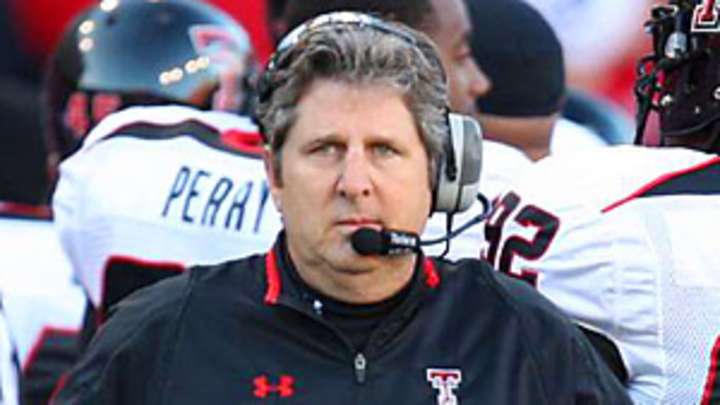Legal showdown between Leach, Texas Tech may just be starting


The legal showdown between football coach Mike Leach and Texas Tech administrators reached a breaking point Wednesday when the university fired Leach for cause, effective immediately. The firing relieves Texas Tech of its remaining financial obligations in Leach's employment contract, which runs through 2013 and sets the stage for Leach to bring a wrongful termination lawsuit against the university.
Leach, who had been suspended by Texas Tech on Monday, has come under fire for his decision to require redshirt sophomore receiver Adam James to stand in an equipment garage while the rest of the team practiced. A son of ESPN analyst and former New England Patriots running back Craig James, James was reportedly recovering from a mild or slight concussion at the time, and speculation persists that Leach disbelieved either the existence or severity of James' injury. James apparently felt humiliated by Leach's decision and that he was being wrongfully punished for having suffered a football-related injury which precluded him from practicing
Leach received notice of his firing only minutes before he was to appear in a Lubbock, Tex., courtroom to seek a temporary restraining order that would have reinstated him as coach. Leach argued that he was suspended without due process and in violation of his contract. The TRO would have restrained Texas Tech from continuing its suspension.
Leach, who reportedly refused Texas Tech's request that he apologize to James, asserted that he received no credible opportunity to present his side of the James story and that he would be personally harmed if not able to coach the Red Raiders in the Alamo Bowl on Jan. 2.
By firing Leach for cause, effectively immediately, Texas Tech relieves itself of any compensation owed to Leach. The "for cause" aspect of the firing is extremely important: it relieves Texas Tech of financial obligation to Leach (though reports indicate that Texas Tech might still pay him a $800,000 payment that will be due Dec. 31). If Leach had been fired without cause -- for instance, if Texas Tech simply felt a coaching change would help the Red Raiders succeed -- he would have been owed $400,000 each year from 2010 to 2013. It is plausible that Leach will seek a wrongful termination claim, among other possible claims, against Texas Tech, seeking to recover not only damages under his employment contract, but also damages for harm to his reputation.
Was Texas Tech legally entitled to fire Leach for cause? In addition to requiring Leach to follow Texas Tech procedures and polices and to provide responsible treatment of players' health, Leach's contract lists the circumstances under which Texas Tech could dismiss him for cause:
1) The commission of a major NCAA violation or an excessive accumulation of secondary violations by Leach.
2) Knowingly condoning NCAA violations by any staff member under his direct control.
3) Failure to take appropriate disciplinary action against any staff member committing NCAA violations.
4) Failure to take appropriate disciplinary action against football student-athletes.
5) Indictment for a felony criminal act.
6) A misdemeanor involving moral turpitude.
Worded literally, the six circumstances for cause might not cover Leach's alleged misbehavior. Leach has neither been charged with a felony nor a misdemeanor (Nos. 5 and 6), nor is there any indication that he will be. Even if Leach is eventually sued by James in a civil claim, such as for false imprisonment or intentional infliction of emotional distress, such a claim would not constitute a criminal charge. There is also no indication that Leach failed to take appropriate disciplinary action against football players in this situation (No. 4). Similarly, there are no allegations of major NCAA violations or accumulation of secondary violations (No. 1).
An arguable nexus between James' behavior and the "for cause" stipulations could emerge in Nos. 2 and 3. The NCAA has developed player safety rules that Leach arguably breached when he instructed staff members to isolate Leach. The NCAA is also considering new rules that would demand particularly safe care for players who have suffered concussions. Texas Tech could also refer to more generalized language in the contract requiring Leach to follow university rules and to provide responsible treatment of players' health.
With many disputed facts as to what happened, however, Leach could maintain that it was at best premature for Texas Tech to fire him for cause. Leach might also argue that his firing reflects wrongful retribution because it occurred right before he sought to protect his legal rights in the form of a temporary restraining order.
Potential litigation might extend beyond Leach and Texas Tech. James, for instance, could bring a torts lawsuit against Leach for false imprisonment and intentional infliction of emotional distress and also argue that Texas Tech was vicariously responsible for the coach's actions.
In addition, both the NCAA, which is considering a new rule that would sideline a student-athlete for at least the rest of the day if he or she loses consciousness, and Congress, which recently held hearings to examine the relationship between concussions and playing football, are likely monitoring the Leach-Texas Tech battle with great interest.
